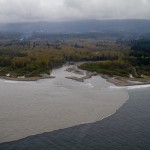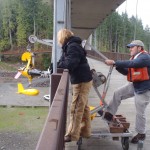23 October 2012
WASHINGTON—The largest dam-removal project in history has increased river water cloudiness caused by suspended particles, a process that could affect aquatic life. The dismantling of two large dams on the Elwha River in Washington began in September of last year and has significantly increased this river cloudiness, known as turbidity, even though most of the sediment trapped behind the dams has yet to erode into the river.

The turbid waters of the Elwha River and the coastal waters of the Strait de Fuca mix directly offshore of the river mouth, forming a large coastal plume. Two large dams on the Elwha River are being incrementally removed from 2011 to 2013 to restore river functions in this important salmon-bearing river. During early stages of the removal project, hundreds of thousands of tons of fine-grained sediment (mostly silts and sands), trapped for decades behind the dams, were released causing turbidity in the river and coastal waters. (Credit: John Felis, USGS)
“The construction of dams can cause major disruptions to natural processes on riverways, and we can expect their removal to also have anomalous effects for some time until rivers regain their equilibrium,” said U.S. Geological Survey Director Marcia McNutt. “What we are learning from the response of the Elwha River ecology to increased sedimentation during dam removal will help guide other large dam removal and river restoration projects in the future.”
The U.S. Geological Survey authors examined sediment and water-flow data from the first six months of dam removal and found that dam-removal activities and natural processes both affected the river’s turbidity. Breaching of several temporary earthen dams built to assist with deconstruction caused sustained increases in downstream turbidity. High river flows associated with rainfall also increased turbidity, at measuring stations both above and below the dams.
“During the first six months of dam removal, most of the sediment released was silt and clay, which caused substantial—but not unexpected—turbidity in the river and coastal waters. As dam removal progresses we expect more and more sand and gravel to be released into the river, which will likely help build river bars and slow coastal erosion near the Elwha River mouth,” said Jonathan Warrick, lead author of the report and research geologist for the USGS. “Although the river has been quite turbid since dam removal began, most of the sediment-transport action is yet to come.”
This first published report on sediment response to the Department of Interior’s Elwha River Restoration Project, is published today in Eos, the weekly newspaper of the American Geophysical Union.
High turbidity levels can reduce the amount of light penetrating river and coastal waters, which can inhibit aquatic plant growth and affect wildlife that rely on sight to find food and avoid predators.

USGS researchers Chris Curran and Raegan Huffman retrieve instrumentation to measure sediment concentration from the Elwha River, Washington. Two large dams on the Elwha River are being incrementally removed from 2011 to 2013 to restore river function in an important salmon-bearing river. The USGS is sampling sediment from the river during the dam-removal project to quantify the magnitude and timing of sediment released during the restoration project. One third to one half of 24 million cubic yards of sediment is expected to be released and flow downstream during the next 3 to 6 years. (Credit: Jon Czuba, USGS)
Removal of the dams is exposing more than 24 million cubic yards of sediment stored in the reservoirs, enough to fill the Seattle Seahawks’ football stadium eight times. Using a combination of measurements from a station downstream of the dams, the authors estimated that less than 1 percent of the 24 million cubic yards of sediment stored behind the dams had eroded and moved downstream. Thus, the authors conclude that completion of dam removal in 2012–2013 will expose much more sediment to erosion, resulting in continued turbidity downstream as well as changes in the shape and sedimentary makeup of the riverbed and the coastal landforms around the mouth of the river into the Strait of Juan de Fuca, which is only 5 miles below Elwha Dam.
“Tracking these changes will be important to assessing their effects on habitat for fish and other wildlife in what historically was one of the most productive salmon rivers in Puget Sound,” Warrick said. Scientists expect dam removal to cause short-term adverse effects on aquatic life, followed by large-scale ecosystem resurgence once the river’s sediment load returns to a more normal and natural state.
Dam decommissioning has become an important means for removing unsafe or obsolete dams and for restoring rivers to a more natural state. Two dams are being removed incrementally during this 2-year project: the 105-foot-high Elwha Dam impounding Lake Aldwell and the 210-foot-high Glines Canyon Dam impounding Lake Mills.
Only part of the total sediment stored behind the dams—9 to 10 million cubic yards—is expected to erode into the river and move downstream to coastal areas. The methods and schedule of dam deconstruction are largely governed by management of this sediment, with controlled drawdowns of the reservoir levels to prevent deleterious impacts of an abrupt release.
More information on the Elwha River Restoration can be found on web pages hosted by the USGS and theNational Park Service. This research and monitoring was funded by both the USGS and the U.S. EPA.
Joint Release
AGU Contact:
Kate Ramsayer, +1 (202) 777-7524, [email protected]
USGS Contact:
Paul Laustsen, +1 (650) 454-7264, [email protected]
Journalists and public information officers (PIOs) of educational and scientific institutions who have registered with AGU can download a PDF copy of this paper.
Or, you may order a copy of the paper by emailing your request to Kate Ramsayer at [email protected]. Please provide your name, the name of your publication, and your phone number.
Neither the paper nor this press release are under embargo.
“River turbidity and sediment loads during dam removal”
Jonathan A. Warrick
Pacific Coastal and Marine Science Center, U.S. Geological Survey, Santa Cruz, California;
Jeffrey J. Duda
Western Fisheries Research Center, U.S. Geological Survey, Seattle, Washington;
Christopher S. Magirl and Chris A. Curran Washington Water Science Center, U.S. Geological Survey, Tacoma, Washington
Jon Warrick: Telephone: (831) 460-7569; Email: [email protected]